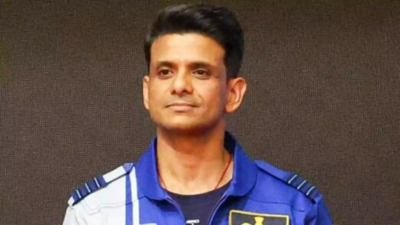The Axiom-4 mission successfully launched from NASA's Kennedy Space Center on Wednesday, embarking on a journey to the International Space Station (ISS).

Carrying a crew of four private astronauts, including India's Shubhanshu Shukla, alongside Anne McClain, Nichole Ayers, and Peggy Whitson, the mission aims to transport them to low Earth orbit. Docking is scheduled for Thursday at the space-facing port of the Harmony module, where they will spend two weeks conducting scientific research.
The entire journey, from launch to docking, is expected to take approximately 28.5 to 29 hours. During their two-week stay, the crew will dedicate their time to scientific research and outreach activities aboard the ISS.
The mission commenced from Launch Complex 39A at NASA's Kennedy Space Center in Florida, a location steeped in history as the departure point for Neil Armstrong's lunar mission. The Ax-4 crew, equipped with specialized flight suits, arrived at the pad and entered the Dragon capsule "C213" to perform pre-launch checks with SpaceX and NASA teams.
Approximately 35 minutes before launch, the Launch Director authorized fueling, after activating the crew's emergency escape mechanism. The Falcon-9 rocket then received its supercooled liquid oxygen and RP-1 kerosene fuel. With five minutes remaining, Dragon transitioned to internal power, requiring complete system synchronization for a successful countdown.
At T-0, the Falcon-9's nine Merlin engines ignited, propelling the spacecraft skyward. Within 60 seconds, the vessel exceeded the speed of sound. The critical "Max Q" phase, where the vehicle experiences maximum aerodynamic stress, occurred at 57 seconds. The vessel then continued its trajectory toward low-Earth orbit (LEO), while the crew experienced increasing gravitational forces.
Approximately 150 seconds after launch, the first stage detached and returned to Earth, aiming for an automated landing on a platform in the Atlantic Ocean. The second stage continued to propel Dragon toward its orbit.
Ten minutes post-launch, Dragon separated and began its independent flight. The nose cone revealed critical navigation equipment. The craft reached speeds exceeding 27,000 km/hr, completing an Earth orbit every 90 minutes.
The subsequent 20-24 hours involved precise orbital adjustments. Dragon executed calculated engine burns to align with the ISS trajectory, utilizing GPS, radar, and internal sensors for precise positioning.
Dragon approached the ISS systematically, pausing at designated waypoints from 400 meters inward. Ground control authorized each progression. At 20 meters, the craft's laser sensors and cameras guided it toward the Harmony module's docking port.
The connection occurred in two phases: magnetic soft capture, followed by mechanical hard capture, establishing an airtight seal.
After thorough pressure and leak verification, the crew entered the ISS. The Ax-4 team then began their two-week scientific program, which includes diabetes research. For Shukla, this mission represents a personal triumph and underscores India's growing presence in space.
Newer articles
Older articles
 Wimbledon’s youthful buzz: Smelling of teen spirit ahead of the Championships
Wimbledon’s youthful buzz: Smelling of teen spirit ahead of the Championships
 Nitish Rana Set for Delhi Return After Disappointing Uttar Pradesh Stint
Nitish Rana Set for Delhi Return After Disappointing Uttar Pradesh Stint
 Chess Sensation Praggnanandhaa Joins Magnus Carlsen's Team Liquid Ahead of Esports World Cup
Chess Sensation Praggnanandhaa Joins Magnus Carlsen's Team Liquid Ahead of Esports World Cup
 Gavaskar Calls for Kuldeep Yadav Inclusion in Second Test Amid Bumrah Fitness Concerns
Gavaskar Calls for Kuldeep Yadav Inclusion in Second Test Amid Bumrah Fitness Concerns
 Bennett to take no further part in SA Test, Masvaure named concussion substitute
Bennett to take no further part in SA Test, Masvaure named concussion substitute
 Stokes Lauds England's Opening Duo After Stunning Headingley Chase Against India
Stokes Lauds England's Opening Duo After Stunning Headingley Chase Against India
 Rishabh Pant Redefining Cricket: Greg Chappell Hails Wicketkeeper-Batter as a "Match-Winner"
Rishabh Pant Redefining Cricket: Greg Chappell Hails Wicketkeeper-Batter as a "Match-Winner"
 Nitish Rana Eyes Delhi Return After Disappointing Uttar Pradesh Stint
Nitish Rana Eyes Delhi Return After Disappointing Uttar Pradesh Stint
 India Squad Update: Harshit Rana Released Ahead of Second Test Against England in Birmingham
India Squad Update: Harshit Rana Released Ahead of Second Test Against England in Birmingham
 Steve Smith Eyes Grenada Test Return After Finger Injury
Steve Smith Eyes Grenada Test Return After Finger Injury